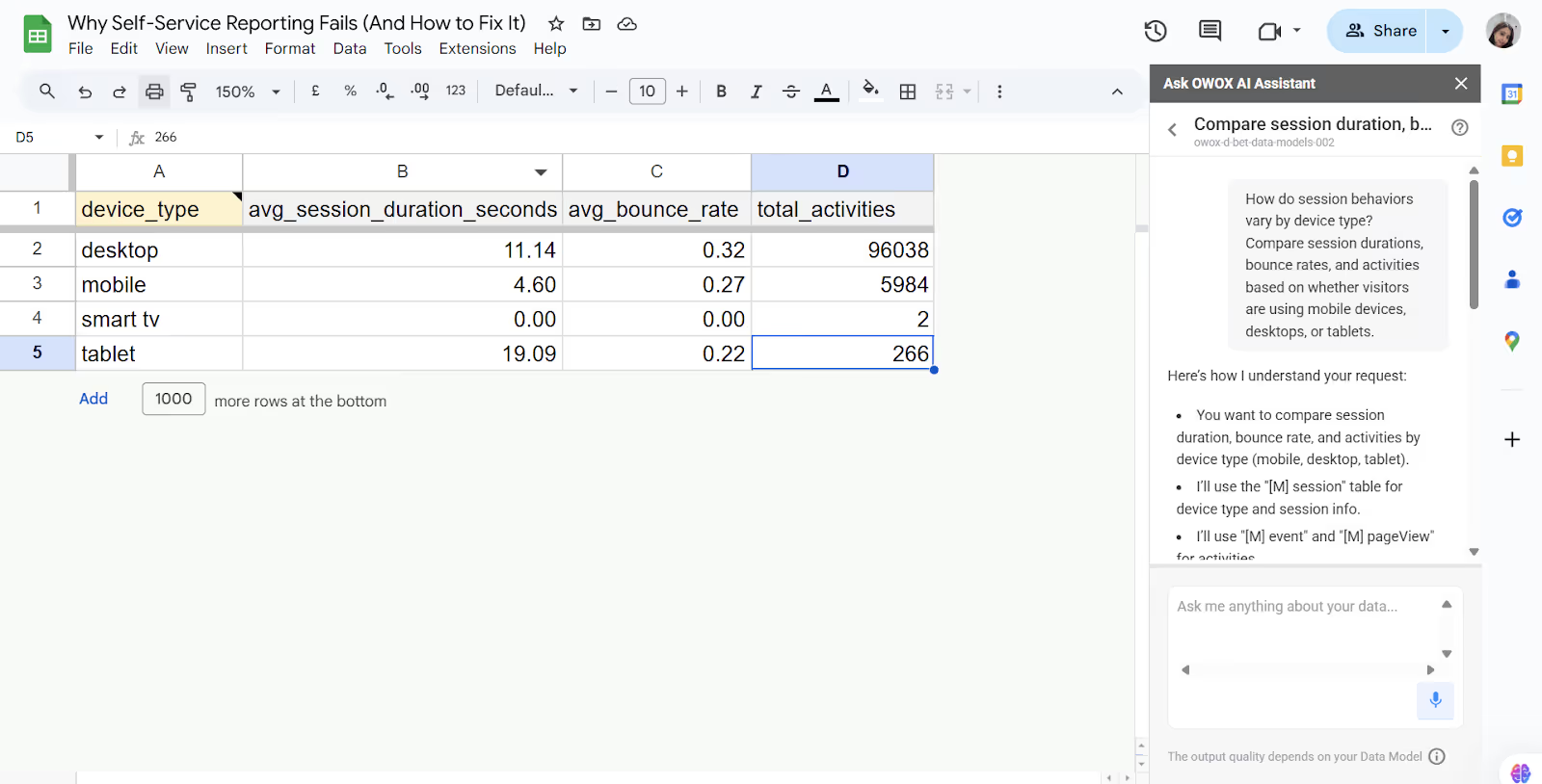Ever wondered why your team keeps asking for the same report every week, even with access to dashboards? Self-service reporting was meant to save time and reduce analyst workload. Instead, it’s created more confusion, duplicated efforts, and inconsistent numbers.

The problem isn’t access, it’s structure. Without a shared logic layer and clearly defined metrics, teams can’t trust what they see. This article explains why self-service breaks down and how to rectify the issue with the right data model.
Companies invested in dashboards, trained every team, and gave open access to tools like Looker Studio and GA4. But the questions haven’t stopped; they’ve just moved to Slack and email. Marketers still don’t trust the numbers, can’t agree on basic metrics, and turn to analysts for help.
What was meant to be a self-service solution has become a marketing reporting nightmare, leaving data teams stuck in the middle.
Here’s where self-service reporting typically breaks down:
Despite good intentions, most self-service reporting systems don’t work as expected. That’s because they’re built on assumptions that seem logical on the surface but don’t hold up in practice. These common myths often lead teams down the wrong path, resulting in broken reports, mistrust in data, and overworked analysts.
Many teams believe that providing everyone with a dashboard is sufficient. Once it’s live, they assume users will stop asking for reports and start making decisions on their own.
Reality: Dashboards only provide access, not clarity. Without context, logic, or shared metric definitions, marketers don’t trust the numbers. They still rely on analysts to explain what the data means.
Connecting GA4, Google Ads, or Facebook Ads to a dashboard tool can give the illusion that reporting is ready to go. The data appears in charts, so it feels like the job is done. Teams end up spending more time cleaning and explaining data than analyzing it.
Reality: These connections bring in raw, unstructured data. Without modeling or consistent metric logic, reports become hard to read, hard to trust, and easy to misinterpret.
The assumption is that access to data tools is enough. Users are expected to explore, build reports, and find answers independently after completing a few training sessions. In reality, most get stuck, confused, or overwhelmed.
Reality: Most marketers aren’t trained to filter, join, or interpret raw data. Without structure, they get stuck, make mistakes, or end up asking analysts to “just do it for them.”
Self-service reporting promises agility, but it can’t function without a solid foundation. Without structured modeling, teams work with inconsistent metrics, misread data, and duplicate efforts.
Raw data from GA4, Ads, or CRM tools is often full of technical fields and nested formats. Without transformation, marketers struggle to understand or use it. They may overlook key insights, rely on guesswork, or abandon the tool altogether, turning back to analysts for clarity and support.
When there’s no central definition, terms like “lead,” “conversion,” or “engagement” are interpreted differently across teams. Each department builds reports based on its logic. This leads to misalignment, conflicting outcomes, and constant questions about which number is right and who owns the source of truth.
A semantic layer translates raw data into clear business terms and consistent calculations. It serves as a guide, ensuring that all reports adhere to the same logic. Without it, dashboards become disconnected, and teams lose trust in the data, wasting time trying to validate or compare different reports.
Self-service reporting isn’t just about giving access to data tools. It requires structure, shared logic, and the right setup behind the scenes. Below are the key elements needed to make self-service work reliably at scale.
When every team defines metrics differently, reporting becomes chaotic. A centralized metrics layer solves this by standardizing key definitions, such as “lead” or “CPC,” across all tools.
This shared source of truth ensures consistency, prevents confusion, and fosters trust in self-service reporting, allowing everyone to work with the exact numbers, regardless of where they view them.
Self-service reporting requires proper data modeling to make datasets usable and accessible. Marketers can’t analyze fragmented tables or figure out joins on their own.
When analysts build clean, well-structured models with defined relationships across sources, business users can explore data confidently, without getting stuck in technical issues or misinterpreting the connections between different datasets.
Dashboards aren’t always the most effective way for marketers to work with data. Many prefer tools they already use, like Google Sheets, or want to ask questions in plain language through chat. Self-service reporting should support these familiar formats, making data access easier, faster, and more aligned with how different teams work on a day-to-day basis.
Analysts should own and define the core logic behind every metric, ensuring it's accurate, consistent, and aligned across the business. Marketers can explore and utilize this logic without needing to change or duplicate calculations. This separation of responsibilities protects data quality while allowing business users to work independently with trusted, pre-modeled metrics in the tools they prefer.
OWOX BI solves the real reason self-service reporting fails: inconsistent logic and unclear metric definitions. It enables analysts to maintain control over the data model while providing marketers with the freedom to explore and utilize data without confusion or delays.
With OWOX BI, analysts define metrics such as “lead” or “cost per lead” directly within the model. This removes ambiguity and ensures every report uses the same logic. Marketers no longer build their formulas or argue over what a metric means, because it’s already clearly defined and consistent across tools.
OWOX BI brings together data from GA4, ad platforms, CRMs, and more under one model. Instead of stitching together exports, reports use a single source of truth. This makes dashboards more accurate, reduces duplication, and ensures teams are always working with clean, aligned data across every source.
OWOX BI integrates with Google Sheets and supports chat-based exploration. Marketers can view metrics, pull updates, or ask questions using the tools they already know.
For example, marketers can ask a question directly in the OWOX AI Assistant in natural language, like: "How do session behaviors vary by device type?"
Instructions: Compare session durations, bounce rates, and activities based on whether visitors are using mobile devices, desktops, or tablets.
To answer this, the assistant will assume:
Then it will ask: “Should the time period remain the last 30 days, or should another range be used?
Once confirmed, the assistant will deliver a clear comparison showing how session behaviors vary across device types and which devices drive the most engagement.

With consistent logic behind every report, teams no longer need to second-guess numbers. There’s no back-and-forth with analysts or rebuilding the same dashboard with new filters. OWOX BI gives marketers confidence in the data, while analysts stop wasting time fixing metric confusion.
Below are common reporting challenges teams face without a centralized model, and how those same scenarios improve once structured logic and shared definitions are in place.
Analysts rebuild reports for every new campaign by duplicating queries and adjusting filters. It’s a repetitive process that consumes time, introduces errors, and delays decision-making.
As requests increase, the workload grows, making it difficult to maintain quality and consistency. Teams spend more time fixing and formatting than analyzing, turning reporting into a bottleneck instead of a solution.
With OWOX BI, campaign reports are pulled from a predefined, centralized model that updates automatically in Google Sheets. Analysts no longer need to rebuild reports or rewrite SQL.

Marketers can access up-to-date numbers on demand, saving hours of rework and back-and-forth. This shift frees up analyst time while delivering faster, more reliable insights to business teams.
Each team defines marketing metrics like “conversion,” “lead,” or “CPC” differently, resulting in mismatched reports and ongoing confusion. Weekly meetings often turn into arguments over which number is correct.
This lack of alignment hinders decision-making, erodes trust in data, and forces analysts to spend hours resolving discrepancies, rather than focusing on meaningful analysis and long-term improvements.
With OWOX BI, key metrics are defined once in the data model and applied consistently across all tools and teams. Whether viewing a dashboard or a spreadsheet, everyone sees the exact numbers and logic. This eliminates conflicting reports, streamlines communication, and allows marketers to act with confidence based on a shared source of truth.
A strong self-service setup doesn’t mean giving up control. With the right model in place, analysts define the logic and maintain data quality, while marketers get the freedom to explore and act confidently on trusted data.
Every report uses metrics defined in the central model, eliminating the risk of conflicting logic. Marketers no longer create custom formulas or misinterpret calculations. Instead, they draw from a single source of truth, ensuring that all reports are consistent, comparable, and aligned across teams and tools.
In OWOX BI, all metrics are predefined and governed through a centralized model. This prevents teams from creating unapproved versions of key metrics. With automated governance, structured metric layers, and clear ownership, every report is based on approved definitions and metrics. If it’s not modeled, it’s not available, ensuring alignment, accuracy, and full trust in the numbers.
With a centralized model, analysts stop spending time fixing broken reports and resolving metric debates. Instead, they focus on building scalable, reusable logic.
This shift empowers marketers to explore and analyze data independently, while analysts maintain control over definitions, becoming enablers of trusted, self-serve reporting rather than bottlenecks in the analytics process.
Most teams assume that adding more tools will fix reporting issues. But the real problem isn’t access or interfaces, it’s the lack of structured, shared logic behind the data. Without modeling, self-service reporting can't succeed.
Teams often begin with visual tools like dashboards or Looker Studio, expecting instant insights. But without defining how data should be calculated, filtered, or joined, the dashboards quickly become confusing. This approach skips the challenging part, building a shared logic layer that ensures consistent and meaningful reporting across tools and teams.
Adding new dashboards only adds new versions of the same metrics. Without defined calculations and shared definitions, every team ends up with its own numbers. The confusion only multiplies, and analysts continue to be drawn into resolving debates. Dashboards are only as useful as the logic that powers them underneath.
With OWOX BI’s semantic layer, analysts define business metrics and logic once, centrally, allowing for consistent and accurate reporting. These definitions automatically apply across all reporting tools, from dashboards to spreadsheets. Marketers get reliable, consistent metrics without writing SQL, while analysts eliminate duplication and reduce the risk of conflicting calculations.
OWOX BI makes self-service reporting truly reliable by allowing analysts to define clear logic, centralize metric definitions, and manage data structures, all in one place.
Marketers gain trusted access to accurate data through familiar tools like Google Sheets or chat, eliminating the need to rebuild logic themselves. With OWOX, reports stay consistent, scalable, and aligned across the business.
Instead of adding more dashboards, you create a single model that powers every report with confidence and clarity.

Self-service reporting enables non-technical users to access, explore, and visualize data independently, without relying on analysts, using tools such as dashboards, spreadsheets, or chat interfaces.

They fail due to unclear logic, inconsistent metric definitions, and raw, complex data. Without a structured data model and a shared understanding, users misinterpret results and continue to rely on analysts.

No. Dashboards only display data. Without a clear semantic layer or defined metrics behind them, they lead to confusion, duplicated work, and constant back-and-forth with analysts.

A data model organizes raw data for use. A semantic layer adds business meaning, defining metrics and logic, so teams interpret data consistently across tools and teams.

Trust is established through centralized metric definitions, clean data modeling, and structured access. When everyone uses the same logic and source of truth, reports become reliable and consistent.

Common tools include Google Sheets, Looker Studio, Tableau, and chat-based assistants like OWOX BI. These tools enable users to explore data without requiring SQL or deep technical knowledge.